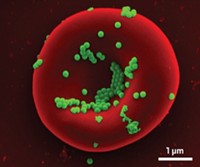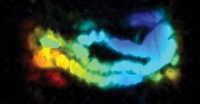Advertisement
Grab your lab coat. Let's get started
Welcome!
Welcome!
Create an account below to get 6 C&EN articles per month, receive newsletters and more - all free.
It seems this is your first time logging in online. Please enter the following information to continue.
As an ACS member you automatically get access to this site. All we need is few more details to create your reading experience.
Not you? Sign in with a different account.
Not you? Sign in with a different account.
ERROR 1
ERROR 1
ERROR 2
ERROR 2
ERROR 2
ERROR 2
ERROR 2
Password and Confirm password must match.
If you have an ACS member number, please enter it here so we can link this account to your membership. (optional)
ERROR 2
ACS values your privacy. By submitting your information, you are gaining access to C&EN and subscribing to our weekly newsletter. We use the information you provide to make your reading experience better, and we will never sell your data to third party members.
Drug Delivery
Star-shaped particles ferry medicine through the skin’s barrier
Titanium-dioxide stars lance the skin with microscopic holes to allow medicine through
by Alla Katsnelson, special to C&EN
March 11, 2020

Skin is the great barrier organ – it excels at keeping foreign particles out of the body. That’s usually a good thing, except when it prevents efforts to ferry medicines through the barrier to treat skin conditions such as skin cancer and psoriasis. Now, researchers report that they have created star-shaped titanium dioxide particles that lance the skin with microscopic holes to allow medicine through (Nat. Med. 2020, DOI: 10.1038/s41591-020-0787-6).
“There are many drugs that are good candidates to put on the skin but are abandoned in development because they are not absorbed well enough,” says Mark Prausnitz, a biomedical engineer at the Georgia Institute of Technology. “This may be a way now to get more drugs into the skin for dermatological purposes.”
Changing a drug’s chemical formulation can boost its absorption somewhat, but additives may have side effects. So Prausnitz’s team took a physical rather than a chemical approach. The particles were inspired by previous work, in which the team created microneedle patches for delivering drugs to small areas of the skin. To deliver drugs to a wider swath of skin, they set out to turn individual microneedles into particles that could then be mixed into a medicine-containing cream or lotion.
The researchers started out with sheets of titanium dioxide – a material widely used in products such as sunscreen and cosmetics. They used a laser to cut three-pointed star-shaped particles from the sheets, then baked the particles in a kiln to strengthen the material. The outermost layer of the skin, the stratum corneum, is bumpy and deformable. Prausnitz thinks that the tips of the stars catch on irregularities in the skin’s surface, poking open small pores through which medicines can enter.
“The micropores that are created are microns in dimension, and any drug you can think of is nanometers in dimension,” says Prausnitz. “So that’s plenty big for a drug molecule to get into the skin, but still microscopically small,” so that it doesn’t damage the skin.
The researchers first tested the particles on pig skin from a slaughterhouse, using a dye that labels the puncture locations. Then, they mixed the particles into two different medicines for testing in mice. In animals that were slathered with a mixture of particles and the melanoma medicine 5-fluorouracil, tumors grew slower, and the mice lived longer. The particles also helped deliver a topical tetanus vaccine, which yielded an immune response as strong as injecting the vaccine intramuscularly. However, a higher dose of vaccine was required to obtain the effect. Finally, the researchers applied a lotion containing the particles to people, who seem to tolerate it well. Prausnitz was the first subject; he and others who tried it say that although it tingled a little, it didn’t differ much from creams and lotions we normally use.
“This is a highly innovative and simple approach with clinical potential for vaccination and treating a variety of diseases,” says Zhen Gu, a bioengineer at the University of California, Los Angeles, who wasn’t involved in the work.
Next, the particles must be tested to see how well they work in getting a drug into the skin in humans, and whether they cause any mischief in the body or in the environment after they perform their skin-poking function.
The researchers hope to license the technology so that the material can be manufactured cheaply at larger scale. That way, says Prausnitz, it can be used not just in pharmaceuticals, but in over-the-counter products such as anti-aging creams.





Join the conversation
Contact the reporter
Submit a Letter to the Editor for publication
Engage with us on Twitter